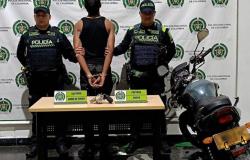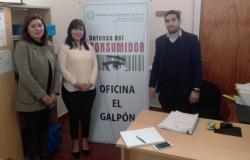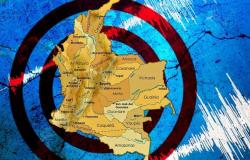Saturday, June 22, 2024, 18:02
Rosario de Velasco (Madrid, 1904-Barcelona, 1991) is the penultimate forgotten painter of Spanish figuration. The Thyssen-Bornemisza Museum now rescues her work and her figure with an exhibition that celebrates how this relegated artist from the generation of ’27, who exhibited in Pittsburgh and Venice with Otto Dix, Edward Hopper, Georgia O’Keeffe, Picasso and Dalí, combined tradition and modernity, looking at the time to the Renaissance and the avant-garde.
The exhibition rediscovers and vindicates the work of one of the great Spanish painters of the first half of the 20th century. Falangist militant critical of Francoism, with communist friends like María Teresa León and imprisoned after fleeing red Madrid, she is ‘resurrected’ thanks to the campaign to locate her unique work carried out by her family on social networks and press.
‘Gypsies’. 1934.
Private collection
Miguel Lusarreta and Toya Viudes de Velasco, journalist and great-niece of the artist, are the curators of the exhibition that until September 15 brings together thirty paintings and as many illustrations. They are mostly works donated by individuals from the 1920s to the 1940s, the most notable in Velasco’s career.
Among them, the oil painting ‘Adam and Eve’ (1932) stands out, on loan from the Reina Sofía Museum, and which Guillermo Solana, artistic director of the Thyssen, renamed ‘Eva and Adam’, “following the will of the artist herself.” Also shining are ‘Maragatos’ (1934), from the Costume Museum in Madrid, or ‘Carnaval’ (1936), from the Pompidou Center in Paris. There are paintings such as ‘Gypsies’ (1935), ‘Things’ (1933) or ‘Portrait of Doctor Luis de Velasco’ (1933) painted during his time in the New Objectivity, and others from his expressionist period, such as the premonitory ‘The Massacre’. of the Innocents’ (1936), from the Museum of Fine Arts of Valencia.
The family kept some works, but most were in the hands of individuals and their whereabouts were unknown until Viudes de Velasco began her fruitful investigation through the internet and some newspapers. “The message ‘I’m looking for the work of my great-aunt, a missing, brilliant and magnificent painter’, caught fire on the networks and soon a lot of photos of the paintings we were looking for were shared,” says the curator. With more than 300 works located, “we managed to make a selection with the Thyssen,” congratulates the painter’s heir, who is still looking for two iconic paintings: ‘Bath’ (1931) and ‘Circus’ (1935).
The killing of the innocent. 1936.
Museum of Fine Arts of Valencia
All the works on display have been restored in the Thyssen workshops, which has allowed the “quality estimation” of the dispersed pieces. Guillermo Solana would believe it “natural” that a museum would acquire one of them “especially” the oil painting ‘Lavanderas’ (1934).
Innocent
Lusarreta assured that the artist “was not silenced” by her Falangist militancy and in the Women’s Section before the Civil War, which did lead to her arrest in Barcelona, and highlights that “her initial ideas varied over the years.” “Painting was a personal enrichment for her,” she says. After a very traumatic process – she was about to be shot in the Modelo prison in Barcelona where her cellmate died – she got married, had her daughter, and dedicated herself to raising her. she specifies Lusarreta.
«My great-aunt did not support the Franco regime at all. When Franco comes to power, she is left in limbo, in no man’s land, without a dealer and with a child. That’s where the forgetfulness of her begins,” says Viudes de Velasco. “My mother reproached Franco for distorting Falangism and considered him an unskilled and clumsy ruler,” notes María del Mar, the artist’s only daughter.
‘Things’. 1933
Private collection
Born into an ultra-Catholic family, Rosario de Velasco Belausteguigoitia trained from the age of 15 with Fernando Álvarez de Sotomayor, a painter of manners and director of the Prado Museum on two occasions. Seduced by Giotto, Masaccio, Piero de la Francesca or Mantegna, she always defined herself as modern within the canons of the classic. She also admired Dürer, Velázquez and Goya and avant-garde artists such as De Chirico, Braque and Picasso, aware from a very young age that she had to go beyond tradition, open herself to new trends and compete as an equal in a predominantly male world.
Rosario de Velasco painting on an image from the 1920s.
Thyssen Museum
Open and restless, she interacted with intellectuals and creators of the generation of ’27, especially with the Sinsombrero, painters and writers at the antipodes of her ideology such as Maruja Mallo, Rosa Chacel or María Teresa León. Also a friend of Pilar Primo de Rivera, her Falangist militancy and her family environment do force her to leave Republican Madrid. She traveled to Burgos, Valencia, France and ended up in Barcelona, where she met Javier Farrerons, a doctor and her future husband, who took her out of prison hidden in a cart. In 1939 she participated in the National Exhibition of Painting and Sculpture, in Valencia, and in 1940 she presented her first individual exhibition in Barcelona.
After its closing in Madrid, the exhibition can be seen at the Museum of Fine Arts of Valencia, from November 7, 2024 to February 16, 2025.
€2/month for 4 months
Are you already a subscriber? Log in





